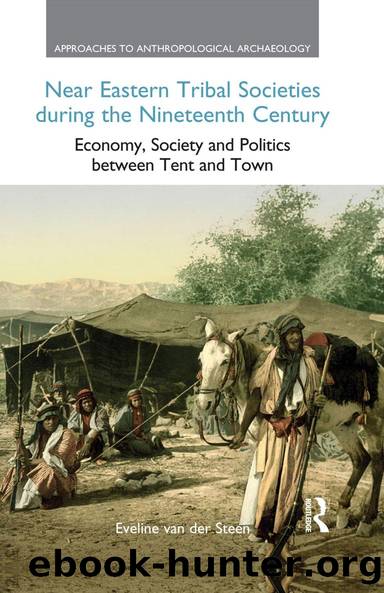Near Eastern Tribal Societies During the Nineteenth Century by Eveline van der Steen

Author:Eveline van der Steen [Steen, Eveline van der]
Language: eng
Format: epub
ISBN: 9781908049834
Barnesnoble:
Publisher: Taylor & Francis
Published: 2013-01-01T00:00:00+00:00
Case study 2: the Majali on the Kerak Plateau
The town of Kerak has always played a prominent role in the history of the Kerak Plateau.3 Archaeological remains date from as early as the Chalcolithic, but the town acquired its main importance in the days of the Crusaders, when Baldwin I built a castle on the top of the mount as part of his fortification programme. The Ayyubids ruled the area from the end of the twelfth century until, in 1263, it fell to Baybars, the Mamluk Sultan, the last Ayyubid stronghold to do so. Baybars made Kerak the capital of his Province of Kerak, and it remained under Mamluk rule until the Ottoman conquest in 1517. The Ottomans created a government in Kerak, but rebellion broke out almost immediately. This was suppressed and a new governor installed. This governor defected, and with the support of local Arabs declared Kerak independent of Ottoman rule. Efforts by the government to bring the district back into line had little effect.
The governmentâs main interest in Kerak was the pilgrimage route, which passed the town directly. This route was now diverted towards the east, to avoid the town and the plateau. As a result, the economic importance of the town declined and the government lost interest in it. It became part of the power play between tribes on the plateau.
After the rebellion that followed the Ottoman conquest was suppressed, the rebels fled to Hebron. The Turkish janissaries mingled with the local population and eventually formed the new leading tribe, calling themselves the Imamiyeh.4 They stayed in power until the eighteenth century, when they were defeated by a new clan, the Majali.
The different stories about how and when the Majali came to power occasionally contradict each other â not an unusual phenomenon in oral tradition. All sources agree that the Majali came from Hebron and descended from the original rebels. They returned to Kerak in the middle of the seventeenth century. During those days, control of the town was disputed between the Imamiyeh and the Beni Amr, a tribal confederation that controlled most of the Kerak Plateau. Around the turn of the century, Salim, head of the Majali family, allied himself to the Beni Amr, and together they trapped the Imamiyeh and massacred them. The Majali now became leaders of the town, but were still subject to the Beni Amr.
Musil (1908/III: 76â84) and Dissard (1905) both tell the story of how the Beni Amr were ousted. Kerak was part of the territory of the Ibn Qaisum, one of the Beni Amr tribes. They tyrannized the town, extracting as much tax as they could and maltreating the inhabitants. They also robbed trade caravans travelling under Beni Amr protection, thus advertising their independence and arousing the anger of the other Beni Amr tribes. The Ibn Qaisum used a conflict with the town as an excuse to expel the inhabitants, who fled to Hebron. While under the protection of the tribes of Hebron, Khalil Majali, the head of the Majali family, who was among the Keraki refugees, married his daughter to the ruling shaykh.
Download
This site does not store any files on its server. We only index and link to content provided by other sites. Please contact the content providers to delete copyright contents if any and email us, we'll remove relevant links or contents immediately.
Cecilia; Or, Memoirs of an Heiress — Volume 1 by Fanny Burney(31438)
Cecilia; Or, Memoirs of an Heiress — Volume 3 by Fanny Burney(31030)
Cecilia; Or, Memoirs of an Heiress — Volume 2 by Fanny Burney(30978)
The Great Music City by Andrea Baker(22608)
We're Going to Need More Wine by Gabrielle Union(18119)
Bombshells: Glamour Girls of a Lifetime by Sullivan Steve(13152)
Pimp by Iceberg Slim(12984)
All the Missing Girls by Megan Miranda(12825)
Fifty Shades Freed by E L James(12487)
Talking to Strangers by Malcolm Gladwell(11969)
Norse Mythology by Gaiman Neil(11952)
Crazy Rich Asians by Kevin Kwan(8405)
Mindhunter: Inside the FBI's Elite Serial Crime Unit by John E. Douglas & Mark Olshaker(7885)
The Lost Art of Listening by Michael P. Nichols(6523)
Enlightenment Now: The Case for Reason, Science, Humanism, and Progress by Steven Pinker(6442)
Bad Blood by John Carreyrou(5810)
The Four Agreements by Don Miguel Ruiz(5568)
Weapons of Math Destruction by Cathy O'Neil(5091)
We Need to Talk by Celeste Headlee(4916)
